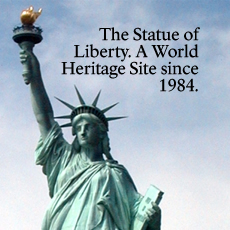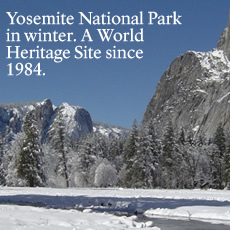
World Heritage Convention |
 |
|||||
The United States established Yellowstone as a national park in 1872 and initiated the worldwide movement to protect such areas as national treasures. One hundred years later, during the Nixon administration, the United States proposed the World Heritage Convention to the international community and was the first nation to ratify it. The World Heritage Convention, the most widely accepted international conservation treaty in human history, is the American national park idea being carried out worldwide. |
||||||
Voluntary NominationsAll member nations of the World Heritage Convention voluntarily nominate their own sites embracing superlative natural or cultural attributes. Among other requirements, the sites must be authentic and meet at least one of several highly stringent criteria for universal value. Each signatory to the Convention maintains sovereignty over its sites, is responsible for their protection, and pledges to assist others in preservation efforts. Direct authority over individual properties remains with the national, state, tribal, or local government or private organization in charge. The Secretary of the Interior, through the National Park Service, is responsible for identifying and nominating U.S. sites to the World Heritage List. Proposed U.S. sites must be either federal property, such as national parks, or sites already designated as national historic landmarks or national natural landmarks. Properties not owned by the federal government are nominated only if their owners wish to do so and pledge to protect their property in perpetuity. Most U.S. World Heritage Sites are administered by the National Park Service. The others are managed by states, private foundations, the Commonwealth of Puerto Rico, and an Indian tribe. While maintaining authority over their own parks, the United States and Canada jointly nominated two World Heritage Sites: Waterton-Glacier and Wrangell-St.Elias/Glacier Bay/Tatshenshini-Alsek/Kluane. The designations underscored the mutually beneficial interaction among the bordering parks in long-term resource management and in such day-to-day activities as mountain and river rescue operations. The Convention is based on key principles. Each nation retains sovereignty and control over its World Heritage Sites. All participating nations pledge to identify and and protect their key natural and cultural sites as part of the heritage of humanity and to cooperate with each other to achieve that goal. By 2010, 186 nations had ratified the World Heritage Convention, and 890 sites in 148 countries had been placed on the World Heritage List. |
Periodic ReportingUnder the World Heritage Convention, both the United States and Canada are required to submit a country-specific periodic report and a joint regional periodic report for North America. Periodic reporting provides the World Heritage Committee with an overview of each participating nation's implementation of the World Heritage Convention and a "snapshot" of current conditions at World Heritage properties. The United States Periodic Report was submitted to the World Heritage Committee in February 2005 and is available here. Additional InformationThe World Heritage Committee is a 21-nation body elected from among all those that have ratified the convention to carry out its program of recognition and mutual assistance. The committee reviews nominations by member countries to the World Heritage List and designates World Heritage Sites. Through the World Heritage Fund, the committee can provide countries requesting assistance with studies, advice, training, and equipment in order to eliminate problems, restore damaged areas, and set up safeguards. The committee also places properties on a List of World Heritage in Danger. This action may be taken in view of such threats to the sites as natural disasters or civil strife. The committee's role, however, is limited to placing sites on both lists and offering technical advice and assistance. Inclusion on the List of World Heritage in Danger imposes no legal requirements but can alert others about concerns at the endangered sites. |
|||
 |
||||
|
U.S. World Heritage Sites |
||||||||||||||
What do national treasures like Yellowstone, the Grand Canyon, Independence Hall and Mesa Verde have in common with the Great Wall of China, the Taj Mahal, the Galapagos Islands and the Tower of London? They are World Heritage Sites. They are such outstanding universally recognized natural and cultural features that they attract the admiration and merit the protection of all people worldwide. They are a heritage Americans share with the world. |
|||||||||||||||
The mere mention of their names evokes this nation's heritage and universal human values. Independence Hall honors the key American governmental documents whose words have echoed in struggles for independence and self-government around the world. |
|||||||||||||||
The U.S. sites also embrace extraordinary natural wonders in the national parks: the world's tallest trees at Redwood, the Earth's longest underground passageways at Mammoth Cave, North America's largest assemblage of glaciers and peaks above 16,000 feet at Wrangell-St. Elias/Glacier Bay, and the world's greatest geyser system at Yellowstone. Similar superlatives can be applied to Carlsbad Caverns, Everglades, Glacier, Grand Canyon, Great Smoky Mountains, Hawaii Volcanoes, Olympic, and Yosemite. The inscription of these 21 American properties as World Heritage Sites formally recognizes the respect they hold in the world community. They are linked today through the contemporary successor to the ancient list of wonders of the world--the World Heritage List. |
|||||||||||||||


